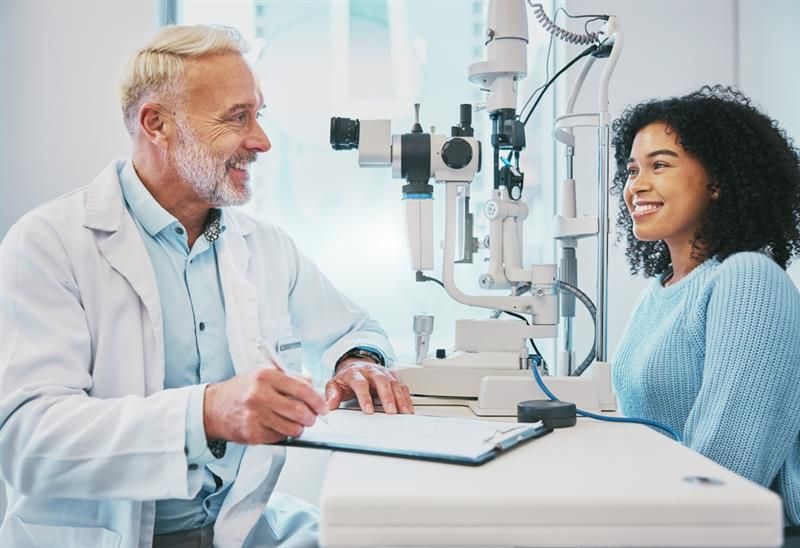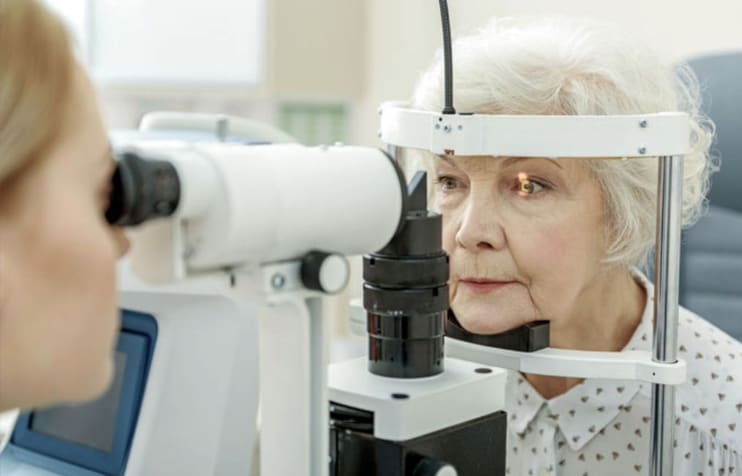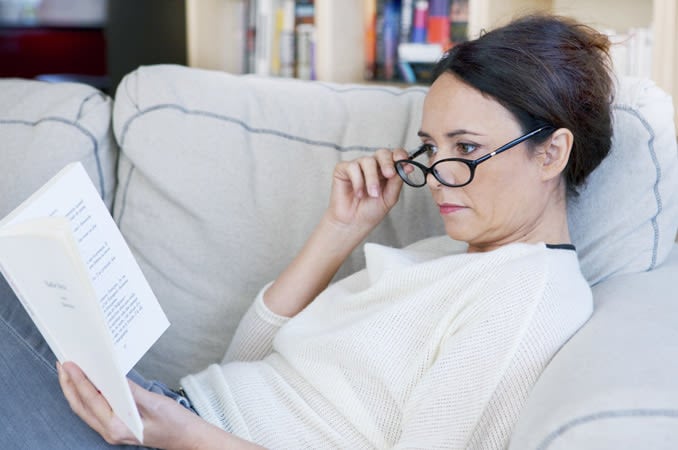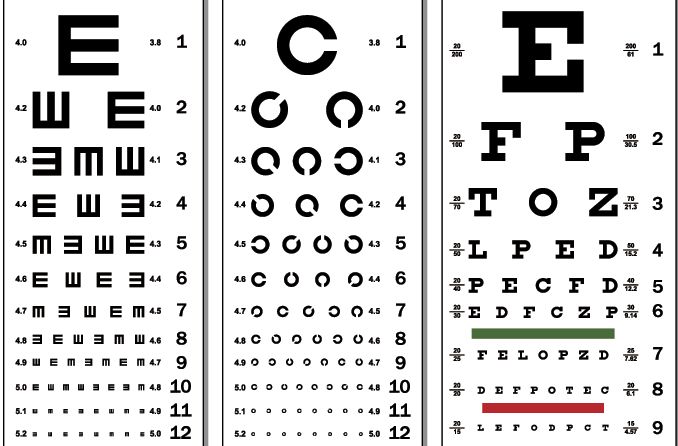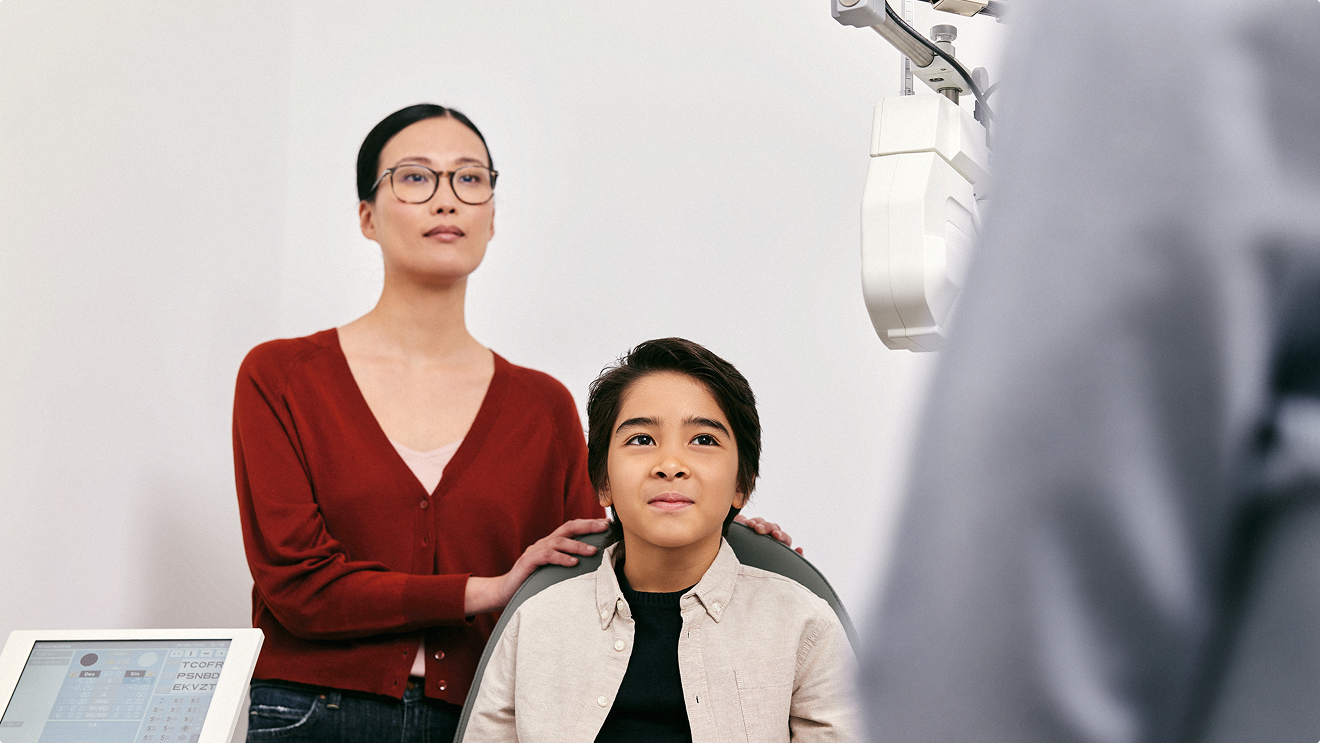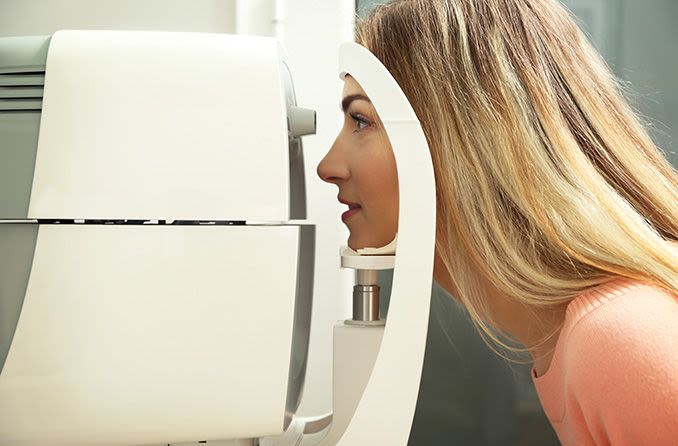Why sight-saving tests matter for older eyes
It’s natural for your eyes to undergo certain changes as you get older. But aging also increases the risk of developing eye diseases that could affect your vision. Regular eye exams and testing allow doctors to detect and treat these conditions early to help preserve your eyesight.
Some age-related eye changes are normal. For instance:
- You may notice that it gradually becomes harder for you to focus on close objects (a condition called presbyopia).
- You may need more light to see clearly, especially in dim environments.
- You may suffer from glare sensitivity when looking at headlights and other bright lights in dark surroundings.
- You may find that certain colors appear less vibrant than they used to.
- You might see spots or squiggly lines (known as floaters) drift across your vision from time to time.
However, other changes could be signs of serious eye problems that need treatment. Some conditions may even develop with little or no noticeable symptoms. That’s why undergoing sight-saving tests and exams is so important as you age.

What happens during a senior eye exam
Geriatric eye exams, also called senior or elderly eye exams, allow doctors to check different parts of the aging eye to identify any changes. These exams often include the following basic tests:
Visual acuity test
Visual acuity is the ability to see clearly at a specific distance. It’s typically expressed as a fraction, such as 20/20, and is measured with an eye chart like the Snellen chart. It has rows of letters that get smaller in size further down the chart.
One eye will be covered at a time while you read the chart from 20 feet away. The smallest line of letters you can read determines your visual acuity. For example, a result of 20/40 means you can see at 20 feet what someone with normal (20/20) vision sees at 40 feet.
This test helps diagnose common vision conditions such as myopia (nearsightedness) and hyperopia (farsightedness).
Eye pressure test (tonometry)
Doctors perform tonometry tests to measure intraocular pressure (IOP), or the pressure inside your eye. This helps screen for glaucoma, a serious condition that can lead to vision loss and blindness if untreated.
Several types of tonometry tests may be used. The most familiar is the air-puff test, which directs a small puff of air onto the eye’s surface. Other tests may involve numbing drops and a small instrument that gently touches the eye to take the measurement.
Visual field tests
Visual field testing evaluates your peripheral (side) vision, or what you see out of the corners of your eyes while looking straight ahead. This helps detect signs of glaucoma or other eye problems. Visual field tests can also be used to assess your central vision and check for signs of age-related macular degeneration (AMD).
Peripheral vision testing
Your peripheral vision can be tested in several ways. In the confrontation visual field test, you cover each eye separately and identify how many fingers your doctor is holding up outside your central vision.
The automated static perimetry test uses a machine with a screen and flashes of light. In this method, you focus on a central point and push a button when you see lights of varying brightness in your side view.
Central vision testing
The Amsler grid is a square overlaid with a grid pattern and a dot in the center. It’s a tool that can be used both in the doctor’s office and at home to aid in the early detection of AMD and other types of retinal disease. If you’ve already been diagnosed with AMD, it can also help track the progression of the disease.
To use the grid, you’ll cover one eye then focus on the dot in the center (then repeat with the other eye). Let your doctor know immediately if any areas of the grid appear empty, dark, fuzzy or wavy. These distortions may indicate new or worsening problems with your central vision.
Refraction test
Doctors perform refraction tests to determine if you need glasses or contacts and how much vision correction is required. This may be done through manual or automated methods:
- Manual refraction – You’ll look through a phoropter (a device with lenses and dials) to identify the lens power that provides your clearest vision.
- Automated refraction – You’ll look through an autorefractor, a device that automatically calculates your glasses or contact lens prescription.
Refraction tests can also help doctors detect signs of other conditions that cause blurry vision, such as age-related macular degeneration, retinal detachment or corneal problems.
Brightness acuity test (BAT)
Also called a glare test, a BAT helps determine how glare affects your ability to see clearly under different lighting conditions. The BAT device simulates varying levels of brightness, including:
- High – Similar to bright sunlight or oncoming headlights
- Medium – Comparable to an overcast day
- Low – Like indoor fluorescent lighting
The results of the test help determine if you have glare disability, which is often caused by conditions like cataracts. If you can’t see as clearly as usual when you’re in the presence of bright light, glare disability may be the cause.
Dilated eye exam
Dilating your pupils (the dark centers of your eyes) is an important part of a senior eye exam. Eye drops are used to temporarily enlarge your pupils, allowing more light into your eyes. This gives your doctor a clearer, wider view of the structures in the back of your eye. This includes the retina, a membrane that senses light, and the optic nerve, which transmits light signals to the brain.
Pupil dilation helps detect signs of cataracts, AMD and other eye conditions. Your doctor may perform this step before other parts of the exam.
Slit-lamp examination
A slit-lamp is a microscope that eye doctors use to examine different parts of your eye. It contains a bright light and magnification power so your doctor can see your eye structures in greater detail.
You’ll be asked to place your forehead and chin against the designated areas of the device while your doctor performs the slit-lamp exam.
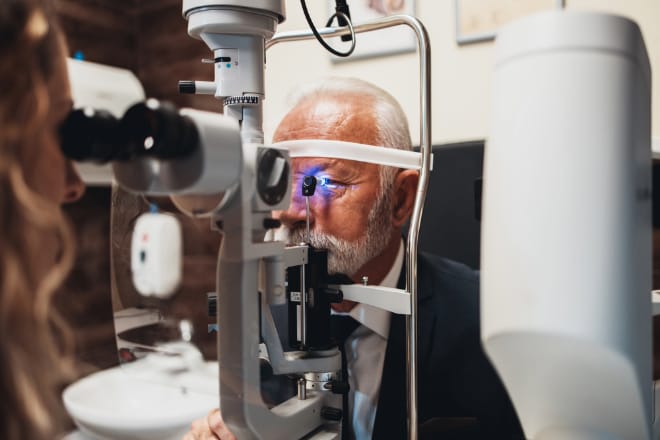
Retinal imaging
Retinal imaging helps detect changes in the retina that may signal serious eye diseases, such as glaucoma, AMD or diabetic retinopathy. Imaging that may be performed during a senior eye exam includes:
- Fundus photography – A special camera takes pictures of the retina, optic nerve and other structures at the back of the eye.
- Optical coherence tomography (OCT) – A device captures cross-sectional pictures of the retina or optic nerve. These images show the layers and thickness of these structures in fine detail.
Other tests
Additional testing may be performed during eye exams for geriatric patients, including:
- Color vision test – This helps determine color vision deficiencies. It involves looking at different cards to see if you can detect certain symbols or figures hidden within various patterns or backgrounds.
- Eye mobility test – This assesses the strength of your eye muscles and how well you can move your eyes. Your doctor will have you follow an object with your eyes as it’s moved in different directions.
- Cover test – This evaluates eye alignment. You will cover each eye at a time while looking at a fixed point straight ahead. When you uncover your eye, your doctor will observe how it moves as you maintain your focus directly in front of you.
- Depth perception (stereopsis) test – This measures how well you can perceive objects in three dimensions (3D) and determine distances. Your doctor may test your depth perception using viewing devices, special 3D glasses or physical objects.
Your eye doctor may recommend further testing based on your exam results, symptoms or risk factors.
Common eye problems in older adults
Regular exams play a key role in identifying eye problems in elderly adults. Some of the more common age-related eye conditions include:
Glaucoma
Glaucoma is a serious group of eye conditions that damage the optic nerve. It’s often caused by increased eye pressure due to poor fluid drainage in the eye. Glaucoma may affect peripheral (side) vision at first.
Without treatment, glaucoma can lead to permanent vision loss or blindness. Since it typically doesn’t cause symptoms until the disease has advanced and permanent damage has occurred, routine eye exams are essential for catching it early.
Cataracts
A cataract develops when the eye’s natural crystalline lens becomes clouded. This occurs when proteins in the lens begin to deteriorate and form clumps. As a cataract progresses, you may notice blurred or hazy vision or changes in your color vision. A brightness acuity test can help determine if your glare sensitivity has been affected by cataracts.
Without treatment, cataracts can lead to vision loss. However, they are usually removed with cataract surgery.
Age-related macular degeneration
Age-related macular degeneration damages the macula, the center part of the retina responsible for your sharpest vision. It typically affects central vision, which is what you see directly in front of you.
AMD symptoms usually don’t occur until the disease advances. Regular screening at home and by your eye doctor with an Amsler grid can aid in early diagnosis and treatment. This can help slow and track the progression of AMD and preserve remaining vision.
Diabetic retinopathy
Diabetic retinopathy can affect people who have diabetes. It develops when high blood sugar damages the retinal blood vessels or causes new, abnormal ones to form. These vessels can swell, leak blood or fluid, and harm the retina. This can lead to vision loss or blindness.
The earliest stages of the condition often show no symptoms. When caught very early, some damage may be reversed with good blood sugar control. If left untreated, it can progress and lead to permanent vision loss, making early detection essential.
SEE RELATED: What is a diabetic eye exam?
Torn retina
A retinal tear occurs when the vitreous, a gel-like substance in the center of the eye, shrinks away from or tugs on the retina (this is known as posterior vitreous detachment). This can cause the retina to tear or break. Retinal tears can result from factors like:
- High myopia (severe nearsightedness)
- Age-related posterior vitreous detachment (most likely to occur between ages 50 and 70)
- Eye injuries
- Eye inflammation
- Previous eye surgeries
In some cases, a torn retina may progress to a more serious condition called retinal detachment, which is when the retina separates from the back of the eye. A detached retina can lead to vision loss or blindness without prompt care.
How often should seniors get eye exams?
According to the American Optometric Association, adults should get an eye exam at least once a year. Some may need more frequent exams, including those who:
- Have certain eye or vision problems
- Have diabetes, high blood pressure or other systemic conditions that affect the eyes
- Have a family history of eye disease
- Have a history of eye surgery
- Take medications that may impact the eyes
- Have other risk factors
It’s important to note that eye exams can also help detect signs of systemic conditions like:
- Diabetes
- High blood pressure
- Heart disease
- High cholesterol
- Stroke
- Certain autoimmune diseases
SEE RELATED: Eye exams for eligible seniors for no out-of-pocket cost
Warning signs to watch for
Geriatric eye exams are important for protecting your vision and eye health as you get older. But don’t wait until your next appointment if you notice changes. Contact your doctor right away if you experience any signs, symptoms or other issues between visits, such as:
Blurry vision
Various age-related eye conditions (aside from presbyopia) can cause your vision to look blurry, including:
- Cataracts
- Glaucoma
- AMD
- A detached retina
Blurry vision should be evaluated by a doctor as soon as possible. However, the sudden onset of blurry vision is a medical emergency. Please seek immediate care if your vision suddenly becomes blurry.
Distorted vision
Distortions in your vision, such as straight lines appearing wavy or bent, could be due to AMD. The condition can also cause blank or dark spots in the center of your view.
While AMD is a common cause of distorted vision, other conditions can also carry this symptom. Let your eye doctor know if you notice any distortion in your vision.
LEARN MORE: What is metamorphopsia (distorted vision)?
Trouble seeing at night
As you age, you may find it more difficult to see at night or in dim environments. This can happen when not enough light reaches the retina or the retina is affected by damage or disease. Night vision problems can be a symptom of serious eye conditions, such as:
- Cataracts
- Glaucoma
- Retinal diseases
Decreased contrast sensitivity
Contrast sensitivity is the ability to distinguish objects from their background, especially when they’re similar in color. While a decrease in contrast sensitivity may happen gradually with age, it can also be a symptom of the following eye conditions:
- Cataracts
- AMD
- Diabetic retinopathy
- Optic nerve problems
Increased sensitivity to light and glare
An increased sensitivity to glare may also occur with age. This can make it difficult to see clearly in certain lighting conditions, such as in bright sunlight or when facing oncoming headlights while driving at night. Glare sensitivity can result from cataracts and other age-related changes in the eye’s natural lens. These changes can cause light to scatter rather than land directly on the retina.
Seeing floaters or flashes
Seeing floaters in your vision from time to time is common with age and is usually not a cause for concern. They often appear as small spots, threads or squiggly lines and are typically more noticeable when looking at a light background.
However, a sudden appearance or increase in the number of floaters, especially along with bright flashes of light in your vision, could indicate a separation of the vitreous gel from the retina or, worse, a retinal tear or detachment. This is a medical emergency and requires immediate care to help prevent irreversible vision loss.
Loss of side vision
Losing your side (peripheral) vision can affect your ability to navigate your surroundings, making everyday tasks like walking and driving more difficult. It can be caused by conditions such as:
- Glaucoma
- Retinal detachment
- Diabetic retinopathy
- Optic nerve problems
Peripheral vision loss can happen slowly or suddenly. Let your eye doctor know immediately if you experience any changes in your vision. Sudden vision changes are a medical emergency and should be treated right away to avoid permanent vision loss.
READ MORE: Signs and symptoms of age-related eye problems
Keep your eyes healthy as you age
Maintaining eye health and vision is important at every stage in life, especially for seniors. Here are some simple tips to help keep your eyes healthy as you get older:
Protect against ultraviolet (UV) exposure
The sun’s UV rays can damage your eyes over time and increase the risk of several eye conditions. Wearing sunglasses with 100% UVA-UVB protection and a wide-brimmed hat can help protect your eyes and vision when spending time outdoors.
Manage systemic conditions
Systemic health problems such as high blood pressure and diabetes can affect the eyes and increase the risk of certain eye problems. Working with your health care provider to control such conditions can protect your vision and help manage eye-related issues.
Eat a healthy diet
Proper nutrition is essential for maintaining eye health and vision. A balanced diet that includes brightly colored fruits, green leafy vegetables, lean meats, fish and whole grains can help support both your eyesight and overall well-being.
LEARN MORE: Boost your diet to protect aging eyes
Exercise regularly
Physical activity is important for many aspects of your health, including your eyes. Regular exercise can help control high blood pressure, diabetes and other systemic conditions that could contribute to eye problems.
Avoid tobacco use
Smoking raises the risk of many health conditions, including cataracts, AMD and other eye diseases. If you smoke or use tobacco products, speak with your health care provider for advice on how to quit.
Get regular eye exams
Early detection and treatment of eye problems can help preserve your vision as you age. For seniors, regular eye exams offer more than just sight-saving benefits. They can also help maintain your independence by preventing vision conditions that could lead to falls or other issues. Eye exams can also enhance your quality of life by providing clearer, more comfortable vision.
Even if you’re not experiencing any eye problems, it’s still important to keep up with routine senior eye exams. Your eye doctor can often spot issues before you notice any symptoms. However, if you experience sudden vision changes or eye pain, seek care right away.
READ NEXT: 8 ways to protect your eyesight
